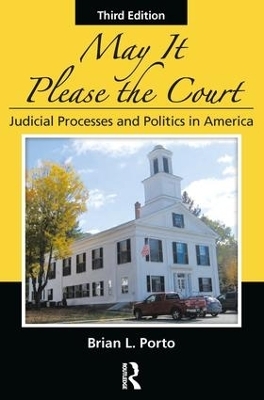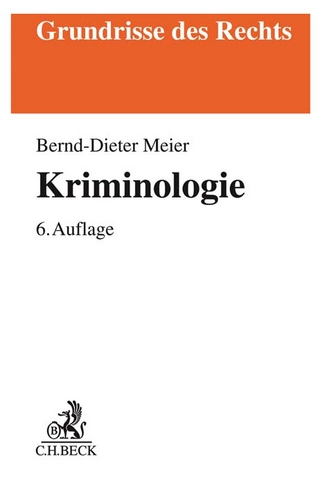
May It Please the Court
Routledge (Verlag)
978-1-138-04340-4 (ISBN)
Unlike the many dull and inaccessible texts in this field, May It Please The Court conveys the human drama of civil and criminal litigation. With an updated epilogue, case studies, and discussion questions, this third edition is a robust resource for criminal justice students.
Brian Porto is a professor at Vermont Law School, where he teaches courses in legal writing, sports law, and election law. He holds a J.D. from Indiana University-Bloomington and a Ph.D. from Miami University (Ohio). He has taught political science at Macalester College (MN) and at Norwich University (VT), and has worked as a lawyer in both state government and private practice. He is licensed to practice law in Vermont and Indiana. Dr. Porto is the author of four books, most recently The Supreme Court and the NCAA: The Case for Less Commercialism and More Due Process in College Sports (University of Michigan Press, 2012), and numerous articles on legal issues and institutions. He lives in Windsor, VT with his wife, Sherrie Greeley. When not teaching or writing, he enjoys hiking, kayaking, and cross-country skiing.
Illustrations
Preface
Acknowledgments
About the Author
1 Courts and Judges in the Political Process 1
1.1 Law and Politics: Myth and Reality 1
1.2 The Political Context of Judging
1.2.1 Courts in the American Political System
1.2.2 Links between Law and Politics
1.2.3 The Differences between Law and Politics
1.3 Reconciling Law and Politics
1.4 Conclusion: Law, Politics, and Judicial Decisions
1.5 Epilogue: The Law and Politics of Public
Protest
2 American Courts—Structures and Procedures
2.1 Federalism and the Judiciary
2.2 State Court Systems
2.2.1 Introduction
2.2.2 Trial Courts of Limited Jurisdiction
2.2.3 Trial Courts of General Jurisdiction
2.2.4 Intermediate Appellate Courts
2.2.5 Courts of Last Resort
2.3 The Federal Court System
2.3.1 Introduction
2.3.2 Specialized Federal Courts
2.3.3 U.S. District Courts
2.3.4 U.S. Courts of Appeals
2.3.5 The U.S. Supreme Court
2.4 Federal Court Administration
2.5 Relations between State and Federal Courts
2.6 Conclusion
2.7 Epilogue: The Roots of Judicial Federalism
3 Lawyers and Lawyering
3.1 Introduction
3.2 A Brief History of the Legal Profession
3.3 The Legal Profession Today
3.3.1 Entry
3.3.2 Culture
3.3.3 Practice
3.3.4 Challenges
3.4 Conclusion
3.5 Epilogue: Campaign Solicitations in Judicial
Elections
4 Judicial Selection and Removal
4.1 Law, Politics, and Judicial Nominations
4.2 Judicial Selection in the States
4.2.1 Introduction
4.2.2 Election
4.2.3 Appointment
4.2.4 Appointment-and-Election
4.2.5 Legislative Election
4.2.6 Conclusion
4.3 Discipline and Removal of State Judges
4.4 Selection of Federal Judges
4.4.1 Introduction
4.4.2 The Lower Federal Courts
4.4.3 The Supreme Court
4.5 Discipline and Removal of Federal Judges
4.6 Conclusion
4.7 Epilogue: Free Speech and Judicial Elections
5 Norm Enforcement—The Criminal Justice Process
5.1 Introduction
5.2 State v. Johnson: Facts
5.3 State v. Johnson: Participants
5.3.1 The Defendant
5.3.2 The Defense Attorney
5.3.3 The Prosecutor
5.3.4 The Judge
5.4 State v. Johnson: Process
5.4.1 Pretrial
5.4.1.1 Arraignment
5.4.1.2 Preliminary Hearing
5.4.1.3 Indictment
5.4.1.4 Plea Bargain
5.4.1.5 Motions
5.4.2 Trial
5.4.2.1 Defendant’s Right to a Speedy Trial
5.4.2.2 Jury Selection
5.4.2.3 Opening Statements
5.4.2.4 Presentation of Evidence
5.4.2.5 Closing Arguments
5.4.2.6 Jury Instructions
5.4.2.7 Verdict
5.4.2.8 Sentencing
5.5 Conclusion
5.6 Epilogue: Dr. Sheppard’s Trial
6 Dispute Resolution—The Civil Justice Process
6.1 Introduction
6.2 Peterson v. Big Pine Mountain Ski Corporation: Facts
6.3 Participants
6.3.1 The Plaintiff
6.3.2 The Plaintiff’s Lawyer
6.3.3 The Defendant
6.3.4 The Defense Lawyer
6.3.5 The Judge
6.4 Process
6.4.1 Pretrial
6.4.1.1 Complaint
6.4.1.2 Answer/Motion to Dismiss
6.4.1.3 Discovery
6.4.1.4 ADR
6.4.1.5 Summary Judgment
6.4.2 Trial
6.4.2.1 The Right to a Jury Trial
6.4.2.2 Jury Selection
6.4.2.3 Opening Statements
6.4.2.4 Presentation of Evidence
6.4.2.5 Closing Arguments
6.4.2.6 Jury Instructions
6.4.2.7 Verdict
6.5 Conclusion
6.6 Epilogue: Punishing Deceit
7 Policy Making—The Appellate Process
7.1 Introduction
7.2 State v. Johnson on Appeal
7.2.1 Post-Verdict Motions
7.2.2 Notice of Appeal
7.2.3 Briefs
7.2.3.1 Appellant
7.2.3.2 Appellee
7.2.3.3 Reply
7.2.4 Oral Argument
7.2.5 Decision Conference
7.2.6 Decision
7.3 Peterson on Appeal
7.3.1 Post-Verdict Motion
7.3.2 Notice of Appeal
7.3.3 Briefs
7.3.3.1 Appellant
7.3.3.2 Appellee
7.3.3.3 Reply
7.3.4 Oral Argument
7.3.5 Decision Conference
7.3.6 Decision
7.4 Conclusion
7.5 Epilogue: Open Fields and a ÒTumbledownÓ House
7.5.1 Open Fields
7.5.2 ÒA TumbledownÓ House
8 Legal and Political Influences on Judicial Decision Making
8.1 Introduction
8.2 Legal Influences
8.2.1 Procedural
8.2.2 Substantive
8.3 Political Influences
8.3.1 Attitudinal
8.3.2 Organizational
8.3.3 Institutional
8.4 Reconciling Legal and Political Perspectives
8.5 Conclusion
8.6 Epilogue: The Law and Politics of Abortion
9 The Limits of Judicial Policy Making
9.1 Introduction
9.2 The Debate about Judicial Policy Making
9.2.1 Overview
9.2.2 Judicial Restraint versus Judicial Activism
9.2.2.1 Judicial Restraint
9.2.2.2 Judicial Activism
9.2.3 Constrained Court versus Dynamic Court
9.2.3.1 Constrained Court
9.2.3.2 Dynamic Court
9.3 An Assessment of Judicial Policy Making
9.3.1 Legitimacy
9.3.2 Capacity
9.3.3 Impact
9.4 Conclusion
9.5 Epilogue: The Coach Who Stood up for
His Players
10 Summary and Conclusion
10.1 Summary
10.2 Conclusion
Appendix A: Researching the Law
Appendix B: Documents of Litigation
B.1 Criminal
B.1.1 Application and Supporting Affidavit for Apartment Search
B.1.2 Search Warrant
B.1.3 Indictment
B.1.4 Motion to Suppress Evidence
B.2 Civil
B.2.1 Complaint
B.2.2 Answer
Index
| Erscheinungsdatum | 15.07.2017 |
|---|---|
| Zusatzinfo | 4 Tables, black and white; 7 Illustrations, black and white |
| Verlagsort | London |
| Sprache | englisch |
| Maße | 156 x 234 mm |
| Gewicht | 703 g |
| Themenwelt | Recht / Steuern ► Allgemeines / Lexika |
| Recht / Steuern ► EU / Internationales Recht | |
| Recht / Steuern ► Strafrecht ► Kriminologie | |
| Sozialwissenschaften ► Politik / Verwaltung | |
| ISBN-10 | 1-138-04340-0 / 1138043400 |
| ISBN-13 | 978-1-138-04340-4 / 9781138043404 |
| Zustand | Neuware |
| Haben Sie eine Frage zum Produkt? |
aus dem Bereich


